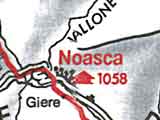Noasca – Fraction San Lorenzo di Piantonetto,m Locana
Centro
750 m
750 m
5.45 h
5.45 h
Noasca 1058 m – Borno 1013 m – Sant’Anna 1481 m – San Lorenzo di Piantonetto 1045 m
The first part of the section, until Prà, is a quiet walk through typical hamlets and can be enjoyed during many months of the year. The second part crosses environments that are sometimes wild, sometimes open onto the valley, with a few short sections that are less easy than usual.
Behind Il Stopover you cross the bridge over the Orco, pass between the houses on the right bank and take a path that goes towards the valley parallel to the river, through pleasant meadows that alternate with broad-leaved groves with some conifers, and with good view of the steep rock walls that dominate the valley; below, on the opposite side runs the provincial road, often protected by avalanche tunnels. You thus cross several villages with houses closely packed together, sometimes with frescoes on the facades as was characteristic in the Canavese area. After Borno 1013 m, and Balme, you pass through the villages of Costetta, Riond and Cater, not far from each other and with valuable frescoes. At Cater you pass over a long bridge and then with a short descent you reach a votive pillar with a triangular plan and frescoes, from which the path becomes a wider path that follows the old communication route of the valley. Shortly after the Prà village, at a ravine where the Orco flows lazily and deep, you cross the river on a bridge to regain the left bank; 1.30 hours.
Follow the provincial road for a short stretch towards the valley until you take, on the left near the village of Fé 900 m, the mule track which passes between the houses, continues between chestnut groves (some trees are centuries-old) and then heads steeply towards the north, touching the villages Carbonere and Coste 1193 m. After the latter, you go up into the steep and wild Frera valley, very branched at the top, among low vegetation especially hazelnuts, and then cross it uphill.
Those who follow the route downhill should not be frightened by the relative exposure of the section in the valley: the path is always well traced. You go up further: when you are almost touching the limit of the latex groves, the slope softens and you proceed between traces of old terraced cultivated fields, now covered with brooms which in the flowering period (here in late summer) constitute an evocative and rather rare in the Graian Alps. You pass by the various scattered and abandoned huts of the Meinardi family and then the Sanctuary of Sant’Anna (1481 m), built in 1877, destroyed a few years later by an avalanche and rebuilt in 1891 with impressive work. A little further on you pass a clearing (with a tunnel which is part of the works of the penstock coming from the Teleccio dam) and continue slightly uphill and on a slight slope, on a paved mule track, between hazel stones up to the structures and the large square built along the way. of the works on the Teleccio dam, 2.30 hours, the materials and mechanical means reached here by cableway and then continued on a road that is now abandoned). Don’t follow the road but go down, with a somewhat difficult route, onto the debris on the left side of the debris dump until you return to the path which initially loses altitude among hazelnuts, alders and large boulders and then among increasingly thicker vegetation of broad-leaved trees.
After the Perebella hamlet 1339 m, you descend among oaks and steep tree-lined meadows to the Bertodasco hamlet 1175 m, also immersed in nettles. Turn left (east) crossing other meadows and woods on the sometimes paved mule track; then, under mighty rocky banks, you pass under the penstock of the Rosone power plant and some cableways still used for the transport of wood and then you turn north, entering the Piantonetto valley and among the chestnut trees you reach the asphalt road near Buriat 951 m. Following the road upstream you quickly reach San Lorenzo di Piantonetto 1045 m; 1.45 hours.
It is the first large village in the Piantonetto valley: it is located on a small plateau and consists of a beautiful group of houses, gathered around a fountain and the small church with a facade.

